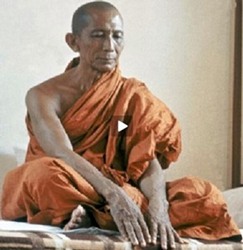All over the Pali canon we can find a frequent recurring pattern in the Buddha’s instruction.
First the Buddha would describe a problem – very often he would analyse what that particular problem might cause. Eventually he would offer a solution, in pragmatic terms point out a path of action. At the end of his instruction he would not forget to provide a short preview of what to expect when the problem actually gets solved. A little motivation for following the path.
In many such instances the Buddha almost wraps his instruction in a fractal like piece of communication. Maybe because he wanted to limit the loss of meaning over time and space, knowing how effective such a pattern would be regarding the inherent loss of meaning through inevitable “noise” or “change” of his words over centuries? 🙂
Here is a less sophisticated and very simple explanation for why the Buddha had to squeeze his entire teaching into as short a message as possible: In the India of 500 BC, the Internet was not yet invented. No emails, instant messages, no airplanes nor cars and hardly any letters could provide means to the interested lay person for getting continuous training from the Buddha and/or his enlightened monks. Meeting the Buddha was a rare and extremely beneficial experience. In those days when you met the Buddha, you would never know, if it was the last time in your life that you would see him. You can imagine how important it became to the individual to remember what the Buddha had said, and how equally dedicated the Buddha would have been not to waste a single word.
 So in order to make sure that his listener got the utmost out of his meeting with the Enlightened One, the Buddha had to condense his message but make sure that he did not miss important points. We can imagine that whenever the Buddha summarized his message to a particular recipient he would probably adjust or highlight certain parts of his teaching to fit the listeners character.
So in order to make sure that his listener got the utmost out of his meeting with the Enlightened One, the Buddha had to condense his message but make sure that he did not miss important points. We can imagine that whenever the Buddha summarized his message to a particular recipient he would probably adjust or highlight certain parts of his teaching to fit the listeners character.
However, in many cases it was clear that that meeting would maybe be the first and last in a lifetime of a listener. In such instances we can see how the entire path – the message of the four noble truths, the path of virtue (sīla), concentration (samādhi) and wisdom (paññā) – was laid down in front of the eager ascetic, lay person or listening monk. The Buddha would hand them over his entire teaching, following his motto, that there was nothing which he kept hidden as a “secret”.*
For us, who are able to look at a multitude of these collected snapshots of the Buddha’s summaries of his teaching – through the faithful and tireless work of generations before us’, such a collection** is a great immeasurable gift. We are in the unique position to view his teaching, over and over again, from various sides. The further we are on the path to the goal pointed out by the Buddha, the more will we understand that he was talking about one and the same experience, his awakening, illustrating it from every possible angle, but, at the same time, repeating himself gazillion times.
 Here is one such superb example: Take for instance the second sutta in the Atthakavagga. Let me show you how in this short sutta of 8 verses the Buddha illuminates the problem in life as suffering caused by a relentless hunt for sense pleasures, then his description of eightfold path as a solution, starting with sila (virtue), the most basic form of self control, leading into concentration, the training of the mind into a tool which culminates in insight and results in an inner detachment – which is crowned by a description of Arahant, or in other words a person who has gone through this training.
Here is one such superb example: Take for instance the second sutta in the Atthakavagga. Let me show you how in this short sutta of 8 verses the Buddha illuminates the problem in life as suffering caused by a relentless hunt for sense pleasures, then his description of eightfold path as a solution, starting with sila (virtue), the most basic form of self control, leading into concentration, the training of the mind into a tool which culminates in insight and results in an inner detachment – which is crowned by a description of Arahant, or in other words a person who has gone through this training.
2. Guhaṭṭhakasuttaṃ – The cave
778. Satto guhāyaṃ bahunābhichanno, tiṭṭhaṃ naro mohanasmiṃ pagāḷho;Dūre vivekā hi tathāvidho so, kāmā hi loke na hi suppahāyā.Caught in the cave (of his body) and manifold covered over,A man remains deeply entrenched in ignorance.So far is such a one from seclusion,For sensual pleasures are not easy to let go in this world.779.Icchānidānā bhavasātabaddhā, te duppamuñcā na hi aññamokkhā;Pacchā pure vāpi apekkhamānā, imeva kāme purimeva jappaṃ.Listening to his wishes and bound to the pleasure of beingSo hard are they to release, no other can release them for usIntent are they on what was and will be, desiring for pleasures here and before.780.Kāmesu giddhā pasutā pamūḷhā, avadāniyā te visame niviṭṭhā;Dukkhūpanītā paridevayanti, kiṃsū bhavissāma ito cutāse.In sensual pleasures excited, overwhelmed, bewildered,They will not listen, used to unwholesame realms;But when pain overcomes them they cry:What will become of us, when we die and fall away from here?
781.Tasmā hi sikkhetha idheva jantu, yaṃ kiñci jaññā visamanti loke;Na tassa hetū visamaṃ careyya, appañhidaṃ jīvitamāhu dhīrā.Therefore a being should train right here himself,Whatever one experiences here in this world as leading to unwholesomeness,Do not follow the path of unwholesomeness caused by it.Live is short – thus say the sages.
782.Passāmi loke pariphandamānaṃ, pajaṃ imaṃ taṇhagataṃ bhavesu;Hīnā narā maccumukhe lapanti, avītataṇhāse bhavābhavesu.I see in this world a shaking –Mankind overrun by thirst to (forms of) being;Low folk who, at the doorstep of death lament –Full of thirsting towards being and non-being.783.Mamāyite passatha phandamāne, maccheva appodake khīṇasote;Etampi disvā amamo careyya, bhavesu āsattimakubbamāno.Look at those, who “mine” and tremble,Like fish in too little water, in a dried out stream;Having seen this, practice “non-mine-ing”,Towards (all forms of) being do not create any attachment.
784.Ubhosu antesu vineyya chandaṃ, phassaṃ pariññāya anānugiddho;Yadattagarahī tadakubbamāno, na lippatī diṭṭhasutesu dhīro.Remove desirous-impulse towards both ends,Thoroughly-understand sense contact, becoming unattached (to it),Don’t do anything for which you would rebuke yourselfA sage stays undefiled in the seen or the heard.
785.Saññaṃ pariññā vitareyya oghaṃ, pariggahesu muni nopalitto;Abbūḷhasallo caramappamatto, nāsīsatī lokamimaṃ parañcāti.Having thoroughly-understood perception you may cross this flood,A silent sage is undefiled by any possession.Having pulled out the dart he proceeds heedfully,Not wishing for this world nor for the next.
===
* Contrary to Mahāyana induced believe, the Pāli suttas clearly state that the Buddha wanted his teaching to shine absolutely clear without holding anything back. In AN we find the saying:
“Tathāgatappavedito dhammavinayo, bhikkhave, vivaṭo virocati, no paṭicchanno”
“O monks, the teaching and guidance proclaimed by the Tathagata shines all openly – not covered up.” AN III. 2. 9
**i.e. the Pali Canon and other (less complete) collections of the memorized words of the Buddha.
